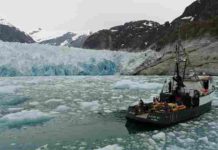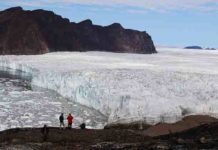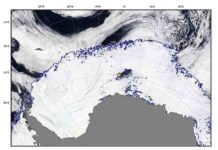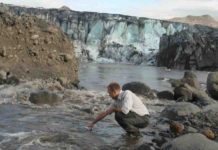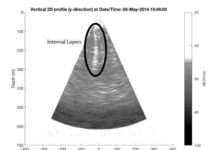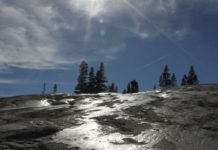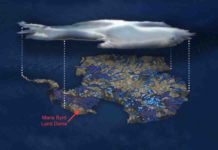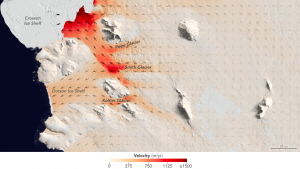
Credit: NASA JPL
Two new studies by researchers at the University of California, Irvine and NASA have found the fastest ongoing rates of glacier retreat ever observed in West Antarctica and offer an unprecedented look at ice melting on the floating undersides of glaciers. The results highlight how the interaction between ocean conditions and the bedrock beneath a glacier can influence the frozen mass, helping scientists better predict future Antarctica ice loss and global sea level rise.
The studies examined three neighboring glaciers that are melting and retreating at different rates. The Smith, Pope and Kohler glaciers flow into the Dotson and Crosson ice shelves in the Amundsen Sea embayment in West Antarctica, the part of the continent with the largest decline in ice.
“Our primary question is how the Amundsen Sea sector of West Antarctica will contribute to sea level rise in the future, particularly following our observations of massive changes in the area over the last two decades,” said UCI’s Bernd Scheuchl, lead author on the first of the two studies, published in the journal Geophysical Research Letters in August.
“Using satellite data, we continue to measure the evolution of the grounding line of these glaciers, which helps us determine their stability and how much mass the glacier is gaining or losing,” said the Earth system scientist. “Our results show that the observed glaciers continue to lose mass and thus contribute to global sea level rise.”
Scheuchl’s team compared radar measurements from the European Space Agency’s Sentinel-1 mission and data from the earlier ERS-1 and ERS-2 satellites to identify changes in each glacier’s grounding line — the boundary where it loses contact with bedrock and begins to float on the ocean.
The grounding line is important because nearly all glacier melting takes place on the underside of this floating portion, called the ice shelf. If a glacier loses mass from enhanced melting, it may start floating farther inland from its former grounding line, just as a boat stuck on a sandbar may be able to float again if a heavy cargo is removed. This is called grounding line retreat.
UCI and NASA researchers found that the Smith Glacier’s grounding line had retreated 1.24 miles (2 kilometers) per year since 1996. The Pope Glacier’s grounding line receded more slowly, at 0.31 miles (0.5 kilometers) annually since 1996. And the Kohler Glacier’s grounding line, which had gradually retreated, actually readvanced 1.24 miles (2 kilometers) since 2011.
Scheuchl credits the Sentinel-1 radar mission with changing the way scientists look at polar ice sheets. “It’s a two-satellite constellation with funding for more than 20 years, and Europe is committing resources for regular ice sheet data acquisitions,” he said. “Our work shows that the data collected is very well-suited for ice sheet science, and we can combine it with other satellite and airborne data sets to establish a more detailed record of these glaciers.”
For a separate study, the NASA Jet Propulsion Laboratory’s Ala Khazendar — a co-author of Scheuchl’s paper — measured ice loss at the bottom of the three glaciers, which he suspected might be influencing the changes in their grounding lines. His work, published today in the journal Nature Communications, involved gauging the thickness and height of the ice via radar and laser altimetry instruments utilized in NASA’s Operation IceBridge and earlier NASA airborne campaigns.
Radar waves penetrate glaciers all the way to their base, allowing direct assessment of how the bottom profiles of the three glaciers at their grounding lines differed between 2002 and 2014. Laser measurements of surface elevation were used to infer changes in the thickness of the floating ice shelves.
Previous studies using other techniques estimated the average melting rates at the bottom of the Dotson and Crosson ice shelves to be about 40 feet (12 meters) per year. Khazendar and his team, analyzing their direct radar measurements, found stunning rates of ice loss from the glaciers’ undersides on the ocean sides of their grounding lines. The fastest-melting glacier, Smith, lost between 984 and 1,607 feet (300 and 490 meters) in thickness between 2002 and 2009 near its grounding line, or up to 230 feet (70 meters) per year.
Those years encompass a period when rapid mass loss was seen around the Amundsen Sea. The regional scale of the decline made scientists strongly suspect that an increase in the influx of ocean heat beneath the ice shelves must have taken place. “Our observations provide a crucial piece of evidence to support that suspicion, as they directly reveal the intensity of ice melting at the bottom of the glaciers during that period,” Khazendar said.
“If I had been using data from only one instrument, I wouldn’t have believed what I was looking at, because the thinning was so large,” he added. However, the two IceBridge instruments, which employ different techniques, both measured the same rapid ice loss.
Khazendar said Smith’s fast retreat and thinning are likely related to the shape of the underlying bedrock over which it was retreating between 1996 and 2014, which sloped downward toward the continental interior, and oceanic conditions in the cavity beneath the glacier. As the grounding line receded, warm and dense ocean water could reach the newly uncovered deeper parts of this cavity, causing more melting.
As a result, Khazendar said, “more sections of the glacier become thinner and float, meaning that the grounding line continues retreating, and so on.” Smith’s retreat might slow down now that its grounding line has reached bedrock that rises farther inland of the 2014 grounding line. Pope and Kohler, in contrast, are on bedrock that slopes upward toward the interior.
The question remains whether other glaciers in West Antarctica will behave more like Smith or more like Pope and Kohler. Many glaciers in this sector of Antarctica are on beds that deepen farther inland, like Smith’s. However, Khazendar and Scheuchl said, researchers need more information on the shape of the bedrock and seafloor beneath the ice, as well as more data on ocean circulation and temperatures, to be able to better project how much ice these glaciers will contribute to the ocean in a changing climate.
Scheuchl’s co-authors on the Geophysical Research Letters study are JPL’s Khazendar and Jeremie Mouginot, Mathieu Morlighem and Eric Rignot from UCI’s Department of Earth System Science.
Khazendar’s co-authors on the Nature Communications study are UCI’s Mouginot, Rignot, Scheuchl and Isabella Velicogna, along with Dustin Schroeder, Helene Seroussi, Michael Schodlok and Tyler Sutterley of JPL.
Reference:
B. Scheuchl, J. Mouginot, E. Rignot, M. Morlighem, A. Khazendar. Grounding line retreat of Pope, Smith, and Kohler Glaciers, West Antarctica, measured with Sentinel-1a radar interferometry data. Geophysical Research Letters, 2016; 43 (16): 8572 DOI: 10.1002/2016GL069287
Note: The above post is reprinted from materials provided by University of California, Irvine.


